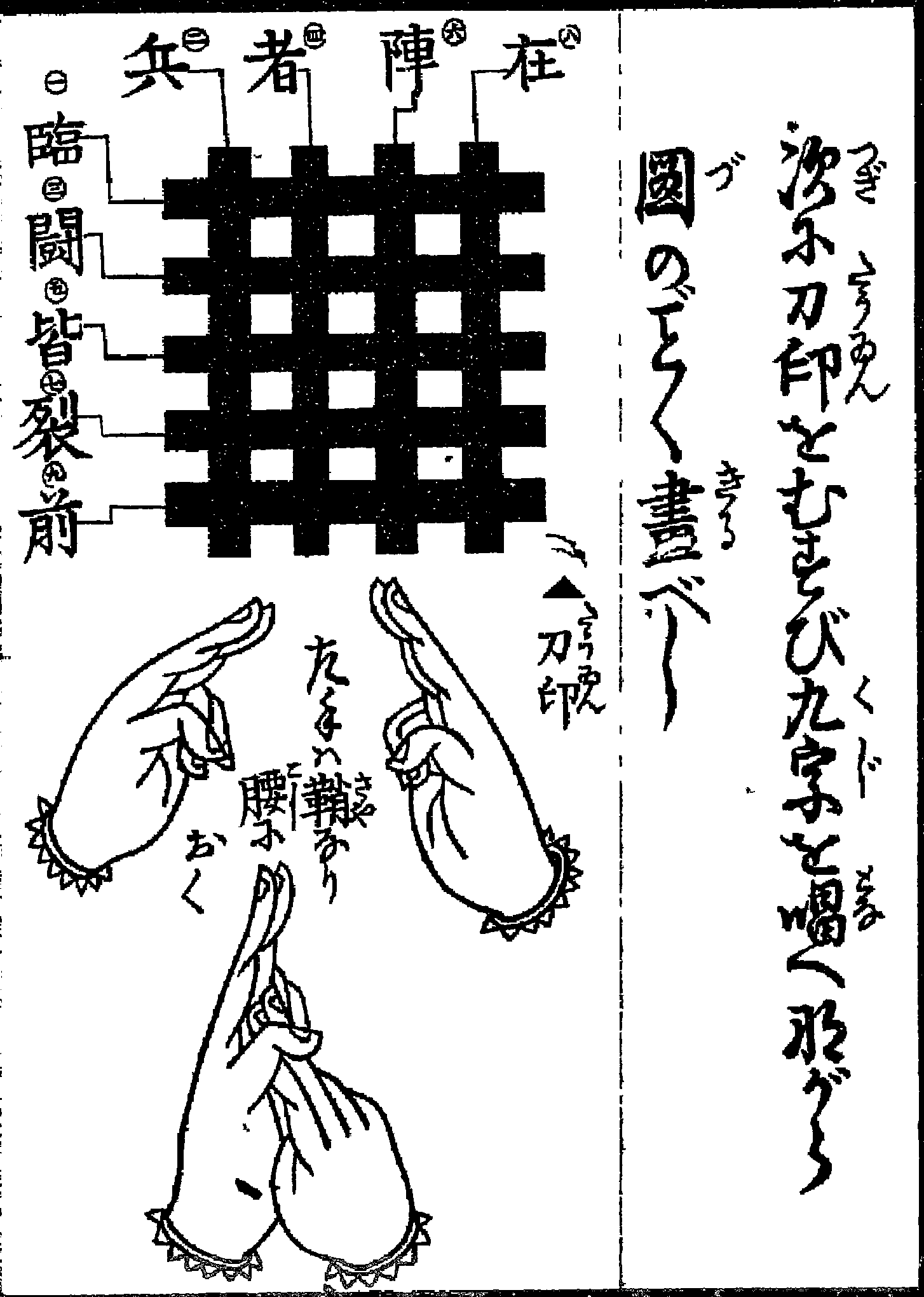Kuji-kiri02 on:
[Wikipedia]
[Google]
[Amazon]
 is a practice of using hand gestures found today in
is a practice of using hand gestures found today in
 is a practice of using hand gestures found today in
is a practice of using hand gestures found today in Shugendō
is a highly syncretic religion, a body of ascetic practices that originated in the Nara Period of Japan having evolved during the 7th century from an amalgamation of beliefs, philosophies, doctrines and ritual systems drawn from local fol ...
and Shingon Mikkyō. It is also present in some old and traditional schools (" ryūha") of Japanese martial arts including but not exclusive to schools that have ties with ninjutsu
, sometimes used interchangeably with the modern term , is the martial art strategy and tactics of unconventional warfare, guerrilla warfare and espionage purportedly practised by the ninja. ''Ninjutsu'' was a separate discipline in some tradit ...
.
The Nine Cuts
* (臨) Rin – Power over oneself & others * (兵) Pyō – Direction of energy * (闘) Toh – Harmony with nature * (者) Sha – Healing of oneself & others * (皆) Kai – Premonition of danger * (陣) Jin– Knowing the thoughts of others * (列) Retsu – Dimension * (在) Zai - Creation * (前) Zen – EnlightenmentReligious symbolism and meanings
The ''Kuji-in
The ''kuji-in'' () also known as ''Nine Hand Seals'' is a system of mudras and associated mantras that consist of nine syllables. The mantras are referred to as ''kuji'' (九字), which literally translates as ''nine characters'' The syllables u ...
'' were created from the gesture of both the hands. The left hand ''Taizokai'' represents a receptive valence, and the right hand ''Kongokai'' conveys an emitter valence. The ''Kuji Kiri'' performed with the right hand are to emphasize the cut of the ignorance of the Maya (illusion)
''Maya'' (; Devanagari: , IAST: ), literally "illusion" or "magic", has multiple meanings in Indian philosophies depending on the context. In later Vedic texts, connotes a "magic show, an illusion where things appear to be present but are not ...
(that is the deceptive sensory world) through the ''Sword of the Wisdom''. In this way, according to the belief system of Shingon Mikkyo, one would come to create an opening in the daily world that would allow oneself to reach various states of consciousness. Derived from the Taoist dualism, Jaho could be seen as Yin
Yin may refer to:
*the dark force in the yin and yang from traditional Chinese philosophy and medicine
*Yīn (surname) (), a Chinese surname
*Yǐn (surname) (), a Chinese surname
*Shang dynasty, also known as the Yin dynasty
**Yinxu or Yin, the S ...
, and Kobudera as Yang
Yang may refer to:
* Yang, in yin and yang, one half of the two symbolic polarities in Chinese philosophy
* Korean yang, former unit of currency of Korea from 1892 to 1902
* YANG, a data modeling language for the NETCONF network configuration pr ...
.
See also
*Kuji-in
The ''kuji-in'' () also known as ''Nine Hand Seals'' is a system of mudras and associated mantras that consist of nine syllables. The mantras are referred to as ''kuji'' (九字), which literally translates as ''nine characters'' The syllables u ...
* Mudra
A mudra (; sa, मुद्रा, , "seal", "mark", or "gesture"; ,) is a symbolic or ritual gesture or pose in Hinduism, Jainism and Buddhism. While some mudras involve the entire body, most are performed with the hands and fingers.
As wel ...
* Glossary of Shinto
* Glossary of Japanese Buddhism
References
External links
* Japanese martial arts terminology Ninjutsu skills Shingon Buddhism Shinto {{Martialart-term-stub